

Essay on History Of Nepal
Students are often asked to write an essay on History Of Nepal in their schools and colleges. And if you’re also looking for the same, we have created 100-word, 250-word, and 500-word essays on the topic.
Let’s take a look…
100 Words Essay on History Of Nepal
Ancient nepal.
Long ago, small kingdoms existed in the area now known as Nepal. The Kiratis ruled during the 7th century BC, and their legacy is still remembered. Later, the Lichhavi dynasty took power around the 3rd century AD, bringing art and architecture to the region.
Medieval Nepal
The Malla kings dominated from the 12th to the 18th century. They built beautiful palaces and promoted culture. In 1482, the Kathmandu Valley split into three kingdoms: Kathmandu, Bhaktapur, and Patan, each competing in art and building temples.
Unification and Expansion
In the 18th century, King Prithvi Narayan Shah unified Nepal. His Gorkha kingdom expanded, creating a larger Nepal. This era was marked by battles and the establishment of a central government.
Rana Rule and Democracy
The Rana family ruled from 1846 to 1951, focusing on power and wealth. In 1951, the Ranas were overthrown, and Nepal slowly moved towards democracy with a constitutional monarchy.
Recent History
Nepal became a federal democratic republic in 2008 after a long struggle. The monarchy ended, and people gained more rights. Despite challenges, Nepal is growing and preserving its rich history and culture.
250 Words Essay on History Of Nepal
Early beginnings.
Nepal’s history is very old and rich. Long ago, small kingdoms were all over the land. In the 4th to 6th centuries, the Licchavi dynasty ruled, and we can still see their art in Nepal. They made beautiful statues and buildings. After them, the Malla dynasty came to power in the 12th century. They too loved art and built many temples and palaces.
Unification of Nepal
In the 18th century, a king named Prithvi Narayan Shah started to bring all the small kingdoms together. By 1768, he had made them all one country, which is the Nepal we know today. This was a big change because before this, Nepal was not one big country but many small ones.
Struggle for Power
After Nepal became one country, there were many fights for power. The Rana family took control in 1846 and ruled for about 100 years. They were very strict and did not let the kings have much power. But in 1951, the people and the king worked together to end the Rana rule.
Recent Changes
In the late 20th century, Nepal’s people wanted a government where they could have a say. This led to big changes in 1990 and again in 2006, when Nepal stopped being a kingdom and became a republic. This means they no longer have a king and the people’s leaders run the country.
Nepal’s history shows us how many small parts can come together to make a whole country. It’s a story of kings, art, and people fighting for a better life.
500 Words Essay on History Of Nepal
Early history of nepal.
Long ago, before it was a country, the land of Nepal was home to many small kingdoms. These kingdoms were ruled by kings and queens who lived in big, beautiful palaces. The history of Nepal is very old, and people have lived there for thousands of years. One of the first groups of people to live in Nepal were called the Kiratis. They were famous for being strong warriors and good hunters. Many stories from those times are still told today.
The Malla Kings
Around the 12th century, a group of kings called the Mallas came to power in Nepal. They built big temples and cities that you can still visit today. These kings liked art and learning, so they helped make Nepal a place where beautiful paintings and big festivals were very common. Because of the Mallas, Nepal became known for its amazing culture and buildings.
In the 18th century, a king named Prithvi Narayan Shah did something very important. He brought all the little kingdoms together into one big country, which is the Nepal we know today. He and his army worked very hard to unite these kingdoms without destroying them. Thanks to him, people from different places in Nepal could be friends and live together in peace.
The Rana Rule
After Prithvi Narayan Shah, there were many kings, but in the 19th century, a family called the Ranas became very powerful. They were not kings, but they controlled the country for about 100 years. During this time, they built many big houses and roads, but they also made the real kings have very little power. The people of Nepal were not very happy with the Ranas because they couldn’t make choices about their country.
Democracy in Nepal
In the middle of the 20th century, the people of Nepal wanted to have a say in how their country was run. They didn’t want the Ranas or just one king to decide everything. So, they fought for democracy, which means that all the people can help make decisions. In 1951, they were successful, and Nepal started to have elections where people could choose their leaders.
Recent Times
The last few decades have been a time of big changes for Nepal. There was a time when the kings had no power, then they had power again, and then in 2008, Nepal decided not to have a king anymore. Now, Nepal is a country where people can vote for who they want to lead them, and it is called a republic. Even though there have been some tough times, like earthquakes and political problems, the people of Nepal keep working together to make their country a better place.
Nepal has a rich history that goes back a very long time. From the brave Kiratis to the unifying king Prithvi Narayan Shah, and from the Rana rulers to the democratic changes, Nepal’s story is full of interesting events. Today, Nepal is known for its beautiful mountains, like Mount Everest, and its kind people who have a strong spirit. The history of Nepal teaches us about the power of unity and the importance of everyone having a voice in their country.
That’s it! I hope the essay helped you.
If you’re looking for more, here are essays on other interesting topics:
- Essay on History Of Middle Earth
- Essay on History Of Money
- Essay on History Of Metals
Apart from these, you can look at all the essays by clicking here .
Happy studying!
Leave a Reply Cancel reply
Your email address will not be published. Required fields are marked *
Save my name, email, and website in this browser for the next time I comment.

Itihasaa: An Encyclopedia of Nepali History
An encyclopedia of nepal.
Itihasaa is an Encyclopedia of Nepali History and the Comprehensive Guide to the broader history of Nepal.
Free Educational Resource
Itihasaa is a Non-Profit and Free Educational Resource with the mission of sharing Nepal’s Invaluable Heritage with the World.
Selfless Commitment to History of Nepal
Itihasaa is a nationalist and patriotic movement aimed at fostering an intellectual culture among the people of Nepal.

Articles (A to Z)
Abhay Malla
Abhaya Malla
Abhiman Singh Basnet
Aditya Malla
Administration of Justice Act 2073
Ananta Malla
Anuparam Gupta
Ashok Challa
Bahadur Shah
Bakhtawar Singh Basnet
Bansaraj Pandey
Bhandarkhal Parva
Bhaskara Malla
Bhaskaradeva
Bhattadhikaran
Bhaum Gupta
Bhim Shumsher
Bhimarjunadeva
Bhimsen Thapa
Bhupalendra Malla
Bhupatindra Malla
Bhuvana Malla
Bintipatra Niksari Adda
Bir Shumsher
Birendra Bir Bikram Shah
Cha Thar Ghar
Chandra Shumsher
Chatra Shah
Civil Rights Act 2012
Commandar-in-Chief
Commercial Treaty of 1792
Conquest of Eastern Nepal
Conquest of Kathamndu Valley
Conquest of Kirtipur
Conquest of Makwanpur
Conquest of Nuwakot
Constitution of Kingdom of Nepal 2015
Constitution of Nepal 2019
Constitution of the Kingdom of Nepal 2047
Dambar Shah
Damodar Pandey
Dev Shumsher
Dharmadhikara
Dharmadhikari
Dibya Upadesh
Drabya Shah
Early Malla Kings of Nepal
Evidence Act 2031
Fourty-Two (42) Saal Parva
Friendship Treaty of 1801
Ganadeva-II
Ganesh Pande
Girvan Yuddha Bikram Shah
Gopal and Mahispal Dynasty
Government Cases Act 2049
Government of Nepal Act 2004
Gunakamadeva
Gyanendra Bir Bikram Shah
Hajiri Goshwara
Hajuriya General
Harisimhadeva
Indo Nepal Relations in Lichhavi Dyansty
Indra Malla
Interim Constitution of Nepal 2063
Interim Government of Nepal Act 2007
Intrepretation of Laws Act 2010
Jagajjaya Malla
Jagajyotir Malla
Jagat Prakash Malla
Jangi Lath-Rana Generals
Jayabhimadeva
Jayadeva First
Jayadeva Malla
Jayadeva Second
Jayajyotir Malla
Jayanandadeva
Jayaprakash Malla
Jayarajadeva
Jayari Malla
Jayarjunadeva
Jayarudra Malla
Jayasimha Malla
Jayastithi Malla
Jayatunga Malla
Jisnu Gupta
Jita and Prana Malla
Jitamitra Malla
Jitari Malla
Juddha Shumsher
Judicial Council Act 2073
Jung Bahadur Rana
Kalu Pandey
Kausi Tosa Khana
Khadga Nissan Adda
Khas Malla Kings of Nepal
Kings of Bhaktapur
Kings of Gorkha
Kings of Kathmandu
Kings of Patan
Kirtiman Singh Basnet
Krishna Shah
Kumari Chowk Adda
Lakshmikamadeva
Laxminarasimha Malla
Legal Aid Act 2054
Legal System of Gorkha
Legal System of Kirat Dyansty
Legal System of Lichhavi Dynasty
Legal System of Malla Dynasty
Lichhavi Administration
Lichhavi Economy
Lichhavi Kings of Nepal
Lichhavi Society
Lokaprakasa Malla
Mahabaladakshya
Mahamandalik
Mahapratihar
Mahasamantas
Mahendra Bir Bikram Shah
Mahendra Malla
Mahindra Malla
Malla Administration
Manadeva II
Manadeva III
Manadeva IV
Manavnyayashastra
Medieval Malla Economy
Medieval Malla Society
Mirmunsi-Rana Figures
Mission of Kirkpatrick 1793
Mohan Shumsher
Muluki Ain 1910
Muluki Bandobasta Adda
Muluki Khana
Munsi Khana
Narasimhadeva
Narbhupal Shah
Narendra Malla
Narendradeva
Naresa Malla
Nepal Law Commission Act 2063
Nrpendra Malla
Padma Shumsher
Parthivendra Malla
Paschimadhikaran
Peace and Friendship Treaty 1950
Police Goshwara
Pradhan Nyayalaya Act 2008
Pratap Malla
Pratap Singh Shah
Prithvi Bir Bikram Shah
Prithvi Malla
Prithvi Narayan Shah
Prithvipati Shah
Punya Malla
Purandarasimha
Purvadhikaran
Raghavadeva
Rajalladevi
Rajendra Bikram Shah
Rajendra Laxmi Shah
Rajyaprakash Malla
Ramasimhadeva
Rana Administration
Rana Bahadur Shah
Rana Prime Ministers of Nepal
Ranajita Malla
Ranodip Singh Kunwar
Ratna Malla
Rddinarasimha Malla
Rise and Origin of Lichhavi Dynasty
Rise and Origin of Malla Dynasty
Rise and Origin of Ranas
Rise and Origin of Shah Dynasty
Sadar Daftar Khana
Sadasiva Malla
Sankaradeva
Sankhar Sakhwa
Sardar-Gorkha
Sarvadandanayak
Shah Kings of Nepal
Shaktisimhadeva
Shankaradeva
Shankaradeva Second
Shivadeva II
Siddhi Narsingh Malla
Sino-Nepal Relations in Lichhavi Dynasty
Sivasimha Malla
Special Court Act 2059
Srinivas Malla
State Cases Act 2017
Sugauli Treaty of 1816 A.D
Sulli/Sholla
Summary Procedure Act 2028
Supreme Court Act 2013
Supreme Court Act 2048
Surendra Bikram Shah
Surya Malla
Taksar and Dhansar
Tej-Narsingh Malla
Thirty-Eight (38) Saal Parva
Trade and Commerce Treaty 1950
Trailokya Malla
Tribhuvan Bir Bikram Shah
Twenty-Six (26) Thithis
Vishnu Gupta
Visnu Malla
Visva Malla
Visvajit Malla
Yaksha Malla
Yoganarendra Malla
Yogaprakasa Malla
Articles (Categories)
Pre-history.
Bhima Gupta
Bhuvana Simha
Bhumi Gupta
Dharma Gupta
Harsa Gupta
Visnu Gupta
Yaksha Gupta
Lichhavi Kings
Origin of Lichhavis
Basantadeva
Ganadeva Second
Manadeva Second
Manadeva Third
Manadeva Fourth
Shivadeva Second
Lichhavi Figures
Sankhadar Sakhwa
Malla Kings
Origin of Mallas
Abhay Malla
Jayadharma Malla
Malla Figures
Jayatunga Malla
Malla Admnistration
Khas Malla Kingdom
Tirhut kingdom, gorkha kingdom.
Origin of Shahs
Partivendra Malla
Rajyaprakasa Malla
Tej Narsingh Malla
Jita And Prana Malla
Unification of Nepal
Conquest of Kathmandu Valley
Conquest of Nuwakot
Modern Figures
Rana regime.
Origin of Ranas
Ranoddip Singh Kunwar
Modern Events
Forty Two Saal Parva
Thirty Eight Saal Parva
Nepali Civilization
Indo-nepal relation.
Lichhavi Dynasty
Medieval Nepal
Commercial treaty of 1792
Friendship Treaty of 1923
Knox Mission of 1802
Peace And Friendship Treaty of 1950
Sugauli Treaty of 1816
Trade And Commerce Treaty of 1950
Sino-Nepal Relation
Army Act 2063
Civil rights Acts 2012
Constitutional Council Act 2066
Education Act 2028
Federation, Province and Local Level Act 2020
Local Administration Act 2028
Political Parties Act 2073
Social Practices Act 2033
State Courts Abolition Act 2017
Constitution
Constitution of the Kingdom of Nepal 2015
Legal System of Nepal
Gorkha Legal System
Kirati Legal System
Lichhavi Legal System
Malla Legal System
Mululi Ain 1910
Nyayabikashini/Manavnyayasastra
Twenty Six Thithis
Gorkha Administration
Amali-Amaldar
Dharmadhikara/Dharmakachahari
Commander in Chief
Hajuriya Generals
Jangi-lath-Rana-Generals
Kausi Tosakhana
- History of Nepal
Nepal is a country in Asia that has an extensive history.
Discussion questions and essay ideas [ edit | edit source ]
- What are some notable events in the history of Nepal?
- What historical lessons can be learned from studying the history of Nepal?
Readings and learning media [ edit | edit source ]
Wikipedia [ edit | edit source ].
- Ancient history of Nepal
- Unification of Nepal
- Kingdom of Nepal
- Nepalese democracy movement
- 1960 Nepal coup d'état
- Nepalese Civil War
- History of Asia
- King of Nepal
- Politics of Nepal
- Outline of Nepal
- Nepal topics
External [ edit | edit source ]
- Interpreting the India-Nepal border dispute
- A Reading Guide to Nepalese History
Videos [ edit | edit source ]
- The History of Nepal (grassroots educational video)
Navigation menu
Academia.edu no longer supports Internet Explorer.
To browse Academia.edu and the wider internet faster and more securely, please take a few seconds to upgrade your browser .
Enter the email address you signed up with and we'll email you a reset link.
- We're Hiring!
- Help Center

Remembering and Remaking Nepal's Founder: A Visual History of Prithvinarayan Shah

2019, Tasveer Ghar
South Asia has many traditions of nationalist iconography of divine mother figures. In this essay, however, we will focus on the history of visual representation of Nepal’s national founding father, Prithvinarayan Shah (r. 1742–75). While the trope of the nation-as-mother is also present in Nepal, as in the commonly-used metaphor of ‘Nepal Aama’, we suggest that the history of visual representation of Prithvinarayan Shah is a particularly interesting lens through which to examine Nepali nationalism because of the fact that his legacy is highly controversial in contemporary Nepal. The king from Gorkha is hailed by many as the nation-builder (rastranirmata), statesman par excellence, and the symbol of national unity for his role in the territorial unification of modern Nepal in the 18th century. On the other hand, many see him as a ruthless conqueror, a warlord, and an imperialist whose legacy of conquest casts a shadow over Nepali society even to this day. Consequently, images of Prithvinarayan Shah play a key role in ideological and political debates over the Nepali past and future. In this essay, we show that among the various images of Prithvinarayan Shah drawn in different styles and across media in different historical periods, a painting by Amar Chitrakar came to acquire a hegemonic status as the most recognized and reprinted image of the king after the 1960s, becoming a visual trope that represents Nepali national unity under the tutelage of the Shah monarch. This portrait (Fig. 01) continues to circulate widely through print media such as textbooks and newspapers and also through the internet and social media, which allow for many creative manipulations of the image. As we will show, the incarnations of Shah’s image are often used to make political arguments about contested aspects of his legacy, such as the unification of Nepal and the establishment of Nepal as a Hindu state. Finally, we suggest that the nationalist mythology and iconography of Prithvinarayan Shah is linked to the masculinist character of the Nepali state.
Related Papers
Marg Publication, edited by Deepak Shimkhada
Dina Bangdel
Marie Lecomte-Tilouine
The fi xed fi gures of kingship expressed in the rituals, and the fl exible event-and actor-based depictions presented in the " royal " narratives off er two contrasting portrayals of kingship in Nepal. We aim at outlining their internal dynamics, starting with the centralisation of the state (late-18th–mid-19th centuries), through the examination of the major royal ritual and the analysis of a royal chronicle. At the centre of these two realities of the kingdom stands the person of the king. In each confi guration, his puzzling position at the crossroads of several identities raises questions about the agency of this polymorphous personage in the functioning of the kingdom. This exploration will lead us to fi nally address the gradual simplifi cation of the fi gure of the king over time, which culminated in the straightforward and opposite statements foreshadowing his end, as either an incarnation of Vishnu or as an anachronistic authoritarian and demonic being.
Jessica Vantine Birkenholtz
The goddess Svasthani's textual-ritual complex is one of Nepal's most popular traditions, celebrated 'in every Hindu household in Nepal'. Yet, despite her ubiquity and popularity, Svasthani is nearly invisible both within and outside of her own tradition. This article examines the elusive identity of this local goddess in an effort to understand where and in what form Svasthani is and is not found and what this tells us about the politics of gender, location, iconography, and Hindu identity in Nepal. I argue that Svasthani gradually transforms from an invisible, private, unfixed, indeterminate goddess into a visible, public, fixed, specific, and local protector of place. In seeking to locate Svasthani within both the pan-Hindu pantheon and Nepal's regional divine and human populations, we are able to see the complexities of coming into being, of being female in Hindu thought and practice, and of being Hindu in medieval and modern Nepal.
Veronique BOUILLIER
in "Gender, Caste and Power in South Asia", ed. JP Neelsen, Delhi 1991
David Gellner
This lecture traces some of the ways in which Nepal has been imagined, starting over 1500 years ago when the name referred to the Kathmandu Valley ruled by the Licchavi dynasty. That spatialised hierarchical conception (‘Nepal mandala’) is contrasted with later ideas of Nepal as interface, empire, nation-state, and multicultural federal republic. At each stage, Nepal has been imagined as made up of different kinds of people. In the modern period formal and official categorisations have become increasingly egalitarian and, recently, even explicitly antihierarchical. Since 1990, ethnic identities have been massively transformed and politicised. Entirely new ‘macro categories’ have come into existence. However, the old order has not simply disappeared, but remains ‘back stage’, reworked; it can be discerned in informal but still powerful hierarchies of language and national belonging.
Annex 2: Chronology
Andrea de la Rubia
The research work Modern Art of Nepal (1850-1990). Picturing a Nation, Performing an Identity consists in an historical reconstruction, and critical analysis, about the process of development of the avant-garde aesthetics in Nepalese art, promoted over the last centuries as a visual means of communication for the cultural definition of the Himalayan Kingdom and its national identity.
Sacred Kingship in World History: Between Immanence and Transcendence, eds A.A. Moin & A. Strathern
Nepal was proud to label itself ‘the world’s only Hindu kingdom’ from 1960 to 2007. In 1990 the central place of the monarchy both in the country’s constitution and in its understanding of itself was, for most people, still utterly taken for granted. Yet just 17 years later the country became a republic. The chapter examines the two main steps taken to ensure that ex-King Gyanendra was not able to project himself as a king in the public sphere: (1) removing him from his role in prominent festivals and replacing him by the president; (2) converting the Narayanhiti Royal Palace into a museum.
Pratyoush Onta
South Asian Popular Culture
Michael Baltutis
RELATED PAPERS
Jesus Salinas
Journal of Materials Chemistry A
abubakar muhammad
Optics Communications
International Journal of Radiation Oncology*Biology*Physics
Zahid Al-mandhari
Journal of the American Society for Information Science and Technology
Sandra Fernández
Malaria journal
Mamadou alpha Diallo
Mathematical Methods in the Applied Sciences
Filomena Cianciaruso
Revista Brasileira de Biociências
Ana Paula Guedes Frazzon
Journal of Environmental Management
Chaithanya Madhurantakam
New Forests
santiago Lozada
Revista Chapingo Serie Ciencias Forestales y del Ambiente
Francisco José Zamudio Sánchez
The International Journal of Health Planning and Management
Somasundaram Arumugam
Wood Material Science & Engineering
Noora Viholainen
Luisa Marquez
Optics and Lasers in Engineering
Emam Z Omar
Bhanu Kiran
Ingeniería e Innovación
OSCAR MANUEL DUQUE SUAREZ
Luis Fernando Zelada Briceño
British Journal of Dermatology
Francesca Prignano
Zbornik Matice srpske za prirodne nauke
Mila Grahovac
Botanica Serbica
Journal of Dental Research
Clifton Carey
ASEG Extended Abstracts
Fatma Nurten Sisman
Eszterházy Károly Katolikus Egyetem Líceum Kiadó eBooks
gabriella daroczi
Journal of Geodynamics
Miroslav Bielik
See More Documents Like This
RELATED TOPICS
- We're Hiring!
- Help Center
- Find new research papers in:
- Health Sciences
- Earth Sciences
- Cognitive Science
- Mathematics
- Computer Science
- Academia ©2024
The history of Kathmandu Valley, as told by its architecture
Professor of Nepali and Himalayan Studies, SOAS, University of London
Disclosure statement
Michael Hutt does not work for, consult, own shares in or receive funding from any company or organisation that would benefit from this article, and has disclosed no relevant affiliations beyond their academic appointment.
SOAS, University of London provides funding as a member of The Conversation UK.
View all partners

The Kathmandu Valley, which was already called “Nepal” centuries before the emergence of the modern nation-state of that name, is a 220 square mile bowl, 4,000 feet up in the lap of the central Himalaya. Its history begins with a myth which tells of how the Bodhisattva (“Buddha-to-be”) Manjushri came down from the north and cleaved the valley rim to release the waters of an enormous lake, thus rendering the valley habitable for the propagation of the Buddhist faith.
The Licchavi kings of the 4th-9th centuries established the valley’s most ancient sacred sites, both Hindu and Buddhist, but it was the Malla kings of the 13th-18th centuries who created its extraordinary built environment. From the lush green rice fields that yielded two or even three crops a year on the fertile soils of the valley floor there arose not one but three tiny city states: Kathmandu, Bhaktapur, and Lalitpur (also called Patan). Each was centred upon a rambling palace complex with a temple-filled square, or Durbar square, adjacent to it, and each competed with the others for control of the lucrative trans-Himalayan trade.
The valley’s indigenous Newars developed their own distinctive style of traditional architecture, of which the multi-tiered “pagoda” temple is the most emblematic form. Their artisans’ fame spread far and wide – even to the court of Kubilai Khan in Beijing.
King Prithvi Narayan Shah of Gorkha, in the hills 80 miles to the west, invaded the valley in the mid-18th century. The Malla kings failed to unite against him and were promptly overwhelmed and displaced. The Shah king simply relocated his court from Gorkha to the Hanuman Dhoka palace in Kathmandu before going on to conquer and annex much of the territory that now constitutes Nepal. The king warmed to the local architecture, and when in 1770 he added a wing to the palace, the famous nine-storey Basantpur Tower, he had it built in the traditional Newar style.


Darbar Square
I made my first visits to Nepal when I was an undergraduate at SOAS in 1978 and 1979. In those days I used to stay in the attic room of the old Paras Hotel, three minutes stroll from the Kathmandu Darbar Square (the room was not usually let out to guests, but I was an impecunious student and the hotelier was kind). The square was not really a square: walking though it from north to south, one threaded one’s way around and between some 25 temples and pavilions, all commissioned by one royal patron or another between the 16th and 20th centuries, spreading along a quarter of a mile on the west of the palace complex. In those days this part of Kathmandu was dilapidated and rustic, but very much alive.
A squat three-storey building called Kasthamandapa (“wood-pavilion”) was tucked into the south-west corner of the square. This was the largest and oldest structure in the traditional Newar style (the first historical reference to it dates from 1143). It is the building from which Kathmandu takes its name.
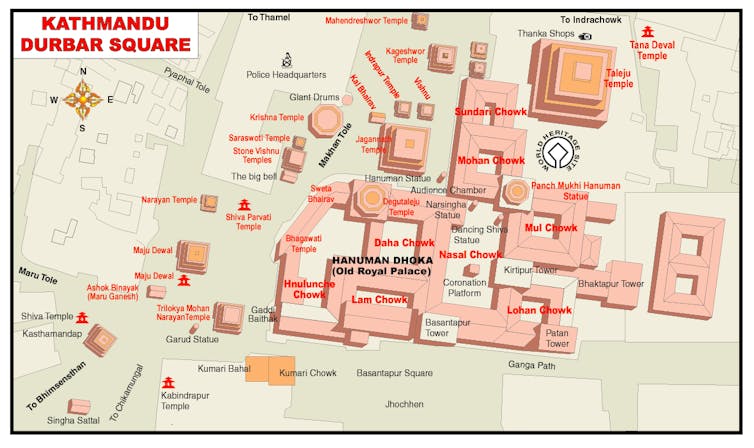
Its ground floor was an open pillared hall on a raised platform, and it stood beside the principal north-south trade route through the old city. It was probably built as a rest house for pilgrims and traders, though some sources suggest that it may have been a royal council hall. I remember the distinctive sound of this old corner of Kathmandu: the tiny Ganesh shrine at the mouth of the Maruhiti alley that leads down to the Bishnumati river had an old brass bell, which almost every passerby paused to ring: it is good to invoke Ganesh, the Remover of Obstacles, as you go about your day.
Just to the east stood Trailokya Mohan Deval (“Mohan of the Three Worlds Temple”), a classic Newar pagoda. This was founded by Parthivendra Malla in memory of his elder brother in 1679, replacing an earlier structure on the site. Into the wooden struts supporting the three sloping tiled roofs were carved representations of the ten incarnations of Vishnu and other Vaishnav deities. On the ground to the west of the temple there knelt a eight-foot Garuda, the man-bird vehicle of Vishnu, created in 1689 from a single piece of stone.
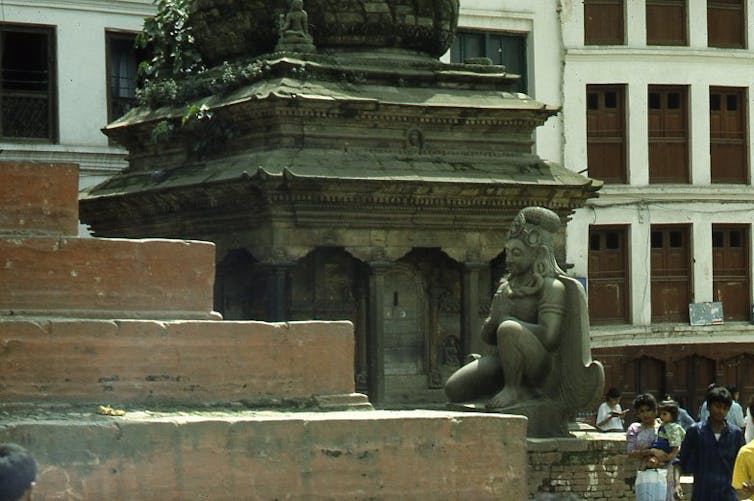
Maju Dega (“Mother-in-Law’s Temple”) was 45 metres to the north. Built in 1690 by Riddhi Lakshmi, the grandmother of King Bhupalendra Malla, it towered 23 metres over the square. Its plinth was a fabulous vantage point: the hippies used to hang out here in the old days, and during national festivals the steps would disappear beneath a sea of colourfully dressed humanity.
The devastation
Kasthamandapa, Trailokya Mohan Deval and Maju Dega are just three of the hundreds of monuments of the Kathmandu Valley’s World Heritage sites that were completely destroyed by the earthquake of April 25 2015 . The upper storeys of the Basantapur Tower have also collapsed. This part of the Kathmandu Darbar Square took the biggest hit of all three palace squares.
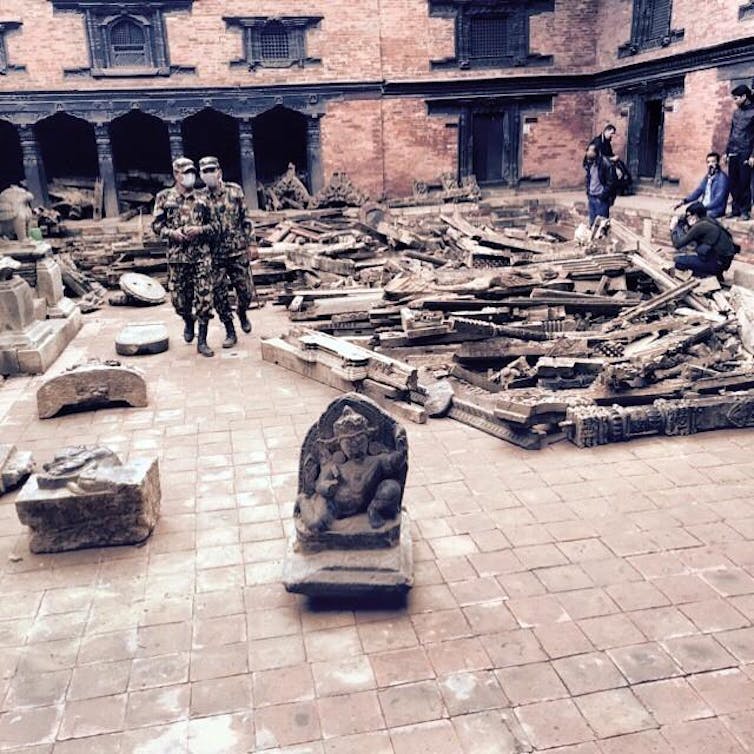
Lives matter more than buildings, and all efforts are rightly focused on humanitarian relief in the immediate aftermath. But at some point in the future, minds will turn to the task of reconstruction. When many of the same buildings were destroyed in 1934, they were rebuilt by local artisans, with little or no help from the outside world. Now, however, many of the old crafts barely survive, and there are serious concerns about the theft of portable cultural artefacts and saleable architectural elements from these sites.
The valley’s cultural heritage was a source of great pride for a nation that has long been beset by political and economic problems, and now by a humanitarian crisis. Making sure that future generations will be able to glory in these places again will be an essential part of the national recovery.
- Architecture
- Nepal earthquake 2015

Senior Research Development Coordinator

Audience Development Coordinator (fixed-term maternity cover)

Lecturer (Hindi-Urdu)

Director, Defence and Security

Opportunities with the new CIEHF
Social Science Baha

- Lecture Series
Ethnography, History, Culture Enduring Oppositions and Creative Dynamism in Nepal
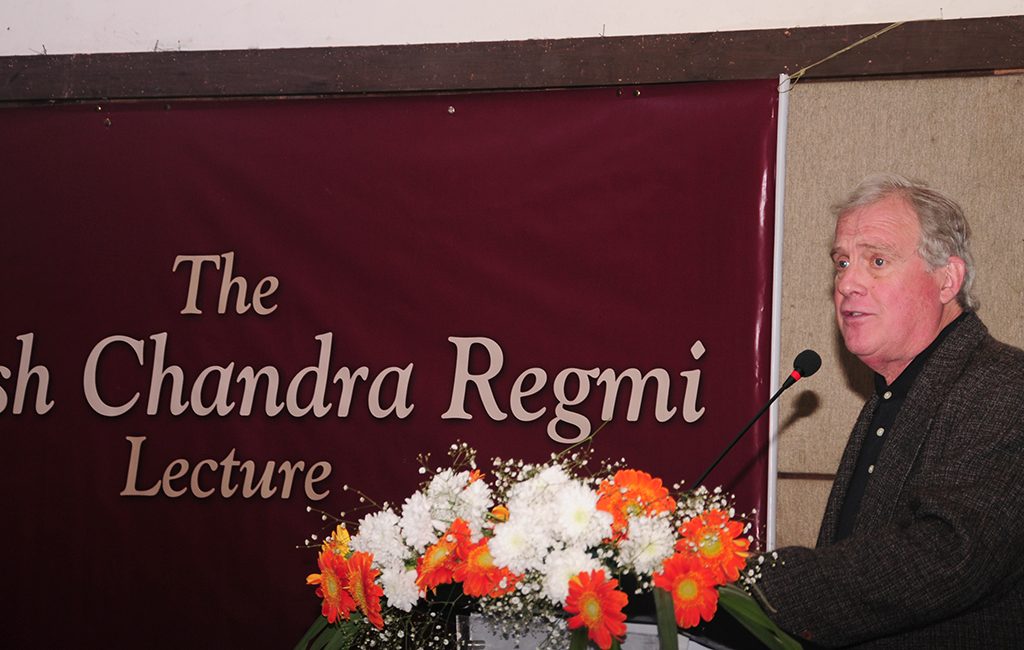
The Mahesh Chandra Regmi Lecture 2017
11 December 2017, Kumari Hall, Hotel Annapurna, Durbarmarg, Kathmandu
Ethnography, History, Culture: Enduring Oppositions and Creative Dynamism in Nepal by David Holmberg
This lecture recapitulates key transformations in western Tamang social and cultural life over the last 50 years. It approaches the question of ‘culture’ and the place of culture in anthropological theorising in the frame of social activism, and views new cultural activism as a direct consequence of the productive capacity of the Tamang in new socio-political contexts. Tamang, historically at the peripheries, are now a dynamic presence in an emerging new configuration of interethnic relations in Nepal. The impossible hope of the Panchayat era to produce, through deculturation, a monolingual, homogenous Nepali culture and society has antithetically produced an as-yet-unresolved counter demand for state recognition of cultural difference by Adivasi Janajati communities in Nepal. While older Tamang villagers lament the demise of the forms of culture they inherited from their past, young people, in an entirely new experiential and communicative environment, are creating new ontologies and producing new forms of cultural distinctiveness that reflect existential realities in contemporary Nepal. Cultural oppositions endure in a world of new political possibilities and new forms of communication, all within an expanding and levelling consumerist economy.
Listen or download lecture in audio format
Professor Emeritus of Anthropology at Cornell University in New York, David Holmberg has been synonymous with anthropological research with the Tamangs in Nepal since the mid-1970s. In an illustrious academic career spanning decades, several generations of Nepal-focused scholars were privileged to be trained by him. He maintains close ties with academic institutions in Nepal, the most significant being the Cornell Nepal Study Program (CNSP) in collaboration with Tribhuvan University, Nepal, initiated in 1993. He also chaired the Department of Anthropology at Cornell University from 1990 to 1997, then again from 2001 to 2008.
Professor Holmberg’s areas of interest include ritual syncretism or hybridity: the relations among Buddhist, shamanic, and sacrificial practices, conceptions of power, state system of forced labor, and history of anthropology of the Himalayas to name a few. His major publications include (with Kathryn S. March, Surya Man Tamang and Bhim Bahadur Tamang) Mutual Regards: America and Nepal Seen through Each Other’s Eyes (Kathmandu: Jeevan Support Printing Press, 1994) and Order in Paradox: Myth, Ritual and Exchange among Nepal’s Tamang (Ithaca: Cornell University Press, 1989). He is currently in the midst of writing a book, Extractive Labor/Productive Ritual based on reconstructing the nature of a state system of forced labour through the memories of villagers and through archival evidence. His most recent appointment was to the Mario Einaudi Center for International Studies at Cornell University as the Fulbright adviser.
Download lecture in pdf
- [email protected]
- Login / Register
Culture and Traditions of Nepal: A Journey Through the Heart of Nepalese Heritage
Article 12 Feb 2023 3269 0
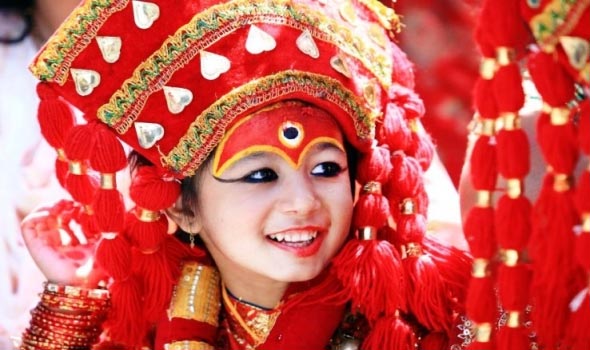
Nepal is a country steeped in rich cultural heritage and traditions. With a unique blend of Hindu and Buddhist influences, Nepalese culture is a vibrant and colorful tapestry of festivals, customs, music, and art. In this article, we'll explore the diverse cultural landscape of Nepal, from its religious roots to the unique traditions of its ethnic groups.
A Brief History of Nepal and its Cultural Influences
Nepal has a long and storied history, with influences from Hindu and Buddhist cultures and the presence of various ethnic groups. The country was ruled by a Hindu monarchy until the late 18th century, when it became a Hindu state. In the 19th and 20th centuries, Buddhism gained popularity, and today both religions coexist in Nepal. This fusion of Hindu and Buddhist beliefs and practices has shaped the country's culture and traditions.
Nepal is a landlocked country located in South Asia and is bordered by India and Tibet (China). Its history is rich and diverse, with cultural influences from the Hindu and Buddhist religions. The country has been ruled by various dynasties and kingdoms throughout its history, and its culture has been shaped by these influences as well as by its geographic location and contact with neighboring countries.
The earliest inhabitants of Nepal were likely animist tribes who worshipped nature and natural elements. Over time, Hinduism and Buddhism were introduced to the country, and these religions have played a major role in shaping its culture and traditions. Nepal was officially declared a Hindu kingdom in the 19th century, but the influence of Buddhism has remained strong, particularly in the northern regions of the country.
Today, Nepal is a diverse country with many different ethnic and cultural groups, each with its own unique customs and traditions. Despite this diversity, there is a strong sense of national identity in Nepal, and its people take great pride in their cultural heritage.
Overview of the Major Religions in Nepal and Their Impact on the Country's Culture and Traditions
The majority of Nepalese people practice Hinduism, and it is the dominant religion in the country. Hinduism has had a profound impact on Nepalese culture and traditions, with many customs, festivals, and rituals being rooted in this religion. The festivals of Dashain and Tihar, for example, are celebrated by Hindus in Nepal and are closely tied to Hindu mythology.
Buddhism is also widely practiced in Nepal, particularly in the northern regions of the country. The Kathmandu Valley is home to many Buddhist monasteries, and the Stupa of Swayambhunath is one of the most important Buddhist pilgrimage sites in the world. Buddhism has influenced Nepalese culture in many ways, including the traditional art and architecture of the country.
Traditional Festivals and Celebrations
Nepal is a country with many colorful and vibrant traditional festivals and celebrations. Some of the most important and widely celebrated festivals include:
- Dashain: Dashain is the biggest and most important festival in Nepal and is celebrated by Hindus across the country. The festival celebrates the victory of good over evil and is marked by feasting, dancing, and the exchange of gifts. The festival lasts for 15 days, and families come together to participate in the celebrations.
- Tihar: Tihar is another major festival in Nepal, and it is also celebrated by Hindus. The festival is also known as the Festival of Lights, and it is marked by the lighting of oil lamps and the decoration of homes with flowers and other decorations. During the festival, families come together to offer prayers, sing songs, and exchange gifts.
- Holi: Holi is a spring festival that is celebrated by Hindus and is known as the Festival of Colors. The festival is marked by the throwing of colored powders and the singing of traditional songs. Holi is a time of joy and celebration and is a time when people put aside their differences and come together to celebrate.
- Gai Jatra: Gai Jatra is a traditional festival that is celebrated by the Newar community in Kathmandu. The festival is a time of celebration and remembrance, and it involves the procession of people dressed in cow costumes. The festival is believed to bring comfort to the families of those who have died in the previous year.
These are just a few of the many traditional festivals and celebrations that take place in Nepal. Each festival has its own unique customs and traditions, and they serve as an important part of the country's cultural heritage.
Unique Customs and Traditions of the Ethnic Groups in Nepal
Nepal is home to a rich tapestry of ethnic groups, each with their own unique customs and traditions. These ethnic groups are an important part of Nepalese culture and contribute to the country's diverse heritage.
- Gurungs: The Gurungs are an ethnic group native to the western region of Nepal and are known for their hospitality and bravery. They have a rich tradition of music and dance and are famous for the Ghantu dance, which is performed during festivals and celebrations. The Gurungs are also known for their traditional woven textiles and handicrafts, which are popular among tourists visiting Nepal.
- Tamangs: The Tamangs are an ethnic group native to the central region of Nepal and are known for their rich cultural heritage. They have a tradition of storytelling, passed down from generation to generation, and are famous for their unique instruments like the Madal drum. The Tamangs also have a rich tradition of metalwork, including the creation of traditional knives and other tools.
- Newars: The Newars are an ethnic group native to the Kathmandu Valley and are known for their elaborate wood carvings, metalwork, and traditional festivals. The Newars have a rich history, dating back to the time of the ancient kingdoms in the Kathmandu Valley, and are known for their distinctive architecture and art. The Newars are also famous for their traditional food, which is a fusion of Nepalese, Tibetan, and Indian cuisine.
The customs and traditions of each of these ethnic groups add to the rich cultural heritage of Nepal and provide a unique insight into the country's diverse history. From the traditional music and dance of the Gurungs to the intricate wood carvings of the Newars, each ethnic group offers a unique glimpse into the customs and traditions of Nepal.
An examination of how modern Nepalese society is impacting traditional cultural practices
With the advancement of technology and globalization, modern Nepalese society has brought about changes to traditional cultural practices. The younger generation is becoming more westernized, and traditional customs and beliefs are slowly being replaced by modern ideas. For instance, the younger generation is more likely to celebrate Western holidays like Christmas, rather than traditional festivals like Dashain and Tihar.
Additionally, with the rise of urbanization, many rural Nepalese are moving to cities, and as a result, traditional practices are being lost. Many of the younger generation do not have access to or the opportunity to learn traditional practices from their elders. The influence of modern society has also led to a decline in traditional crafts like wood carving and metalwork.
However, the Nepalese government and cultural organizations are taking steps to preserve and promote traditional cultural practices. The preservation of cultural heritage is seen as an important aspect of Nepalese identity and is necessary for the continuation of traditional practices.
"Nepal has a rich cultural heritage that has been passed down from generation to generation. It is our responsibility to preserve and promote these traditions so that they can continue to be a part of our identity," says a cultural expert from Nepal.
Preservation and promotion of Nepalese culture and traditions
The preservation and promotion of Nepalese culture and traditions are crucial for ensuring the longevity and relevance of this rich cultural heritage. There are several organizations and initiatives aimed at promoting Nepalese culture and traditions, both domestically and internationally.
For instance, the National Museum of Nepal, located in Kathmandu, serves as a hub for showcasing the country's cultural heritage through its exhibits and cultural programs. The museum works to preserve traditional Nepalese artifacts and promote the country's cultural heritage to both domestic and international audiences.
Similarly, the Nepalese government, along with local communities, have been working to preserve traditional festivals and celebrations. For example, the Gai Jatra festival in Kathmandu has been officially recognized as an important cultural event and is protected by the government, ensuring its continuation for future generations.
In addition to these efforts, cultural exchange programs have been established between Nepal and other countries, promoting the country's unique traditions and customs globally. The Gurkha Museum in Winchester, England, for example, showcases the cultural heritage of the Gurkha soldiers and their contributions to the British Army.
Moreover, there are numerous non-government organizations that are working to preserve and promote the cultural heritage of Nepal. These organizations aim to raise awareness about Nepalese culture and traditions, particularly among the younger generation, to ensure that these customs and traditions continue to be passed down from one generation to the next.
In conclusion, Nepal is a country with a rich and diverse cultural heritage that is shaped by its history, religion, and traditions. From the elaborate wood carvings of the Newars to the traditional festivals and celebrations of Dashain, Tihar, and Holi, Nepalese culture is a tapestry of fascinating customs, practices, and art forms. With a focus on preservation and promotion, Nepalese culture will continue to thrive and provide a unique and rich experience for future generations.
"Nepalese culture is like a treasure trove, with something new to discover at every turn. It is our duty to preserve and promote it, so that future generations can experience and appreciate its richness and diversity," says cultural historian, Dr. Bhagat Singh.
- Latest Articles
A Student's Guide to Conducting Narrative Research
April fools' day facts: origins, pranks & traditions, boosting success: the power of parental involvement in education, parental involvement in education: key to success, primary education in developing nations: overcoming challenges, why sports coaches are embracing cutting edge materials for their equipment, are we born happy exploring the genetics of happiness, list of bank holidays in nepal 2081 (2024 / 2025), how to stand out in a sea of stanford applicants, apply online.

Find Detailed information on:
- Top Colleges & Universities
- Popular Courses
- Exam Preparation
- Admissions & Eligibility
- College Rankings
Sign Up or Login
Not a Member Yet! Join Us it's Free.
Already have account Please Login
- Reveel Protocol Potential Airdrop Backed by Binance
- KiloEX Confirmed Airdrop Invested By Binance Labs
- Chance of Getting Two Potential Airdrop | Backed by Polychain, BinanceLabs and Others
- Caldera Potential Airdrop Invested $9M By Sequoia Capital And Dragonfly
- Polyhedra Network Potential Airdrop biggest Investors are Binance Labs, Animoca Brand, Polychain
Greetinglines
Best Greetings For Loved Ones
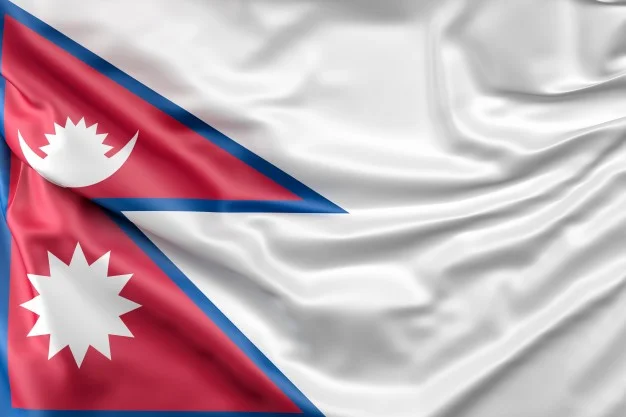
Essay on My Country Nepal For Students
If there is a country’s flag that stands out among all other countries it is the flag of Nepal . Our flag is very unique and cannot be compared to other countries’ flags due to its shape. It also has a hidden meaning behind it which represents the country’s peace-loving and friendly nature, bravery, and immortal history.
My country Nepal is situated between two countries, India and China. Although it is sandwiched between international powers, conflicts have not happened between any, and peace remains. Nepal is a country of various castes and cultures. In other words, it is like a beautiful garden of flowers with people of different ethnicities and backgrounds.
My country Nepal is not only unique for its flag but also its geographical terrain, the variety of castes and cultures you can find, and the rich history of it. It is the land of various great places and important figures that people know far and wide. The temperature here spans from cool to hot and is a heaven for residing in.
There are about 126 castes in Nepal each with its own rich history and culture which makes Nepal a rich place for culture. Some dating back to the millenniums. Not only that, our country is very rich in its geographical terrain. From the lowest point of just 70 Meters from sea level to the world’s highest peak Mt. Everest (8848.86 meters) , we have temperature scales that vary from place to place. It is divided into three regions, Terai, Hilly, and Himalayas each according to their altitude and geographical differences.
Himalayan regions have high and mighty Himalayas that are breathtaking to look at. Out of the world’s top 10 highest peaks, 8 of them fall in my country. It is already a great pride to have come from such a country. The diverse flora and fauna, beautiful landscapes, lush and green jungles, historical and religious places in Nepal are enough to gather the attention of foreigners and locals too. People from all over the world pay thousands of dollars just to see our country’s snow-capped mountains, rivers, cliffs, waterfalls, other beautiful landscapes, the rich flora and fauna, and sites of great religious and historical importance. It just doesn’t end there.
📌 Read – Essay on the Importance of English Language
Our country ranks in the top 5 for the richest in water resources. With just a small country with an area of 1,47,181 sq kilometers, it has the potential to fuel hydropower worth 2% of the entire world. It may look small in number but taking our country’s small area in context, it is a potential incomparable to all. The Terai region holds fertile land and smooth flowing waters that are excellent for farming and cultivating.
Nepal is also known as an agricultural country where 60% of the people here follow agriculture as their work. Our country also has huge historical importance. Gautama Buddha the founder and preacher of Buddhism which is practiced worldwide was also born in Nepal. Buddhism is known to preach peace and non-violence and to love everyone. King Janak is also an important figure who holds great importance to communities in Nepal.
Other personalities include Bhrikuti, Araniko, etc. Our country is also known for its bravery. Our country never has to celebrate Independence day as we were never under the rule of any other. We stood and fought against the Britans and other Mongol countries. Brave Gorkhalis were united after a long struggle and fought their way to preserve their country. The courage and bravery of Nepali people are also know world wide. Many brave Gorkhalis went to fight under countries in world wars and won various colors and medals. This brought our country so much respect that we even enjoy it for granted to date.
Although our country’s history, culture, terrains, and achievements make anyone feel proud, the power struggle for the politicians, previous kings, and presidents have made the country weak and fall in the developing country category. Our rich natural resources have not been utilized and we have fallen way behind. Corruption is widely prevalent in our country and the loans we have taken from other countries are in a large number. The amount of food and other materialistic consumption has made Nepal import more and export less.
Our country is poor but the people here are rich. This is because of the corruption and the illegal working/trading that has been done. The government has not made significant progress and the people aren’t responsible. Although I feel proud to be A Nepali, the condition of my country makes me feel bad. People should feel responsible and carry out their duties and not just complain about the government.
The government too should implement proper policies and rules and enforce them accordingly. Utilization of our natural resources should be done in an effective way and social evils such as discrimination according to castes and genders, other superstitions should be slowly removed. Centralized development should stop and we should control the people moving out to other countries with their skills that are wasted abroad. This way we can slowly develop our country.
Essays on Other Topics
- Essay on Mother – 800+ Words Paragraph
- Essay on Pollution | 800+ Words Paragraph on Pollution
- Essay on Importance of Discipline
- Essay on Globalization | 800+ Words Paragraph on Globalization
If you love our posts the consider following us on our social media channels Twitter @ GreetingLines and Facebook @ GreetingLines , our you can directly reach us via Contact Page .

You May Also Like

Essay on Romeo and Juliet | Paragraph on Romeo & Juliet

Essay on Computer | 600+ Words Paragraph on Computer

How “Text Editors” Are Useful in Writing Research Paper?
28 thoughts on “ essay on my country nepal for students ”.
Thank you so much sir for helpful essay.
Thanks a lot sir .😊👨 its give to get new ideas😊
It’s my humble request to you.that plz write an essay on my country,my paradise.🙏
Thankyou for your essay. It really helped me.
Thank you so much sir for helpful essay.Actually I was searching for essay on my country and luckily found ….
░░░░░░▄████▄ ░░░░░▐▌░░░░▐▌ ░░▄▀▀█▀░░░░▐▌ ░░▄░▐▄░░░░░▐▌▀▀▄ ▐▀░▄▄░▀▌░▄▀▀░▀▄░▀ ▐░▀██▀░▌▐░▄██▄░▌ ░▀▄░▄▄▀░▐░░▀▀░░▌ ░░░░█░░░░▀▄▄░▄▀ ░░░░█░█░░░░█░▐ ░░░░█░█░░░▐▌░█ ░░░░█░█░░░▐▌░█ ░░░░▐▌▐▌░░░█░█ ░░░░▐▌░█▄░▐▌░█ ░░░░░█░░▀▀▀░░▐▌ ░░░░░▐▌░░░░░░█ ░░░░░░█▄░░░░▄█ ░░░░░░░▀████▀
░░░░░░▄████▄ ░░░░░▐▌░░░░▐▌ ░░▄▀▀█▀░░░░▐▌ ░░▄░▐▄░░░░░▐▌▀▀▄ ▐▀░▄▄░▀▌░▄▀▀░▀▄░▀ -: ▐░▀██▀░▌▐░▄██▄░▌ ░▀▄░▄▄▀░▐░░▀▀░░▌ ░░░░█░░░░▀▄▄░▄▀ ░░░░█░█░░░░█░▐ ░░░░█░█░░░▐▌░█ ░░░░█░█░░░▐▌░█ ░░░░▐▌▐▌░░░█░█ ░░░░▐▌░█▄░▐▌░█ ░░░░░█░░▀▀▀░░▐▌ ░░░░░▐▌░░░░░░█ ░░░░░░█▄░░░░▄█ ░░░░░░░▀████▀
You are great sir 😚✌️🤞🙏
I really like your essay it helps me to get new ideas and thoughts 😃💕💕💕💕 Thanks for your nice essay.
Thank for your kind words we appreciate it 😉
Hi I am new user
Thank you Alot sir ❤
Your Welcome 😉
Thank yuh sir. For the great essay. This helps us for getting ideas to write an essay
Thank you so much for such amazing compliment 😊
Am proud to be nepali ❤️❤️❤️🇳🇵🇳🇵🇳🇵🇳🇵 so I knew about the history of our country it’s like a story ❤️❤️🇳🇵🇳🇵🇳🇵
Ya it’s really good to visit in Nepal. Nepal has most beautiful place to look.
Thanku sir for such a helpful and true essay which is outstanding💕💕💕
Thanku sir for your such a helpful and true essay which is outstanding💕💕💕
we are glad that you liked it 😉
Hello there! This post couldn’t be written any better!
Reading this post reminds me of my old room mate! He always kept chatting about this. I will forward this article to him. Fairly certain he will have a good read. Thanks for sharing!
I love what you guys are up too. This kind of clever work and exposure! Keep up the superb works guys I’ve incorporated you guys to my blogroll.
Wonderful blog! I found it while searching on Yahoo News. Do you have any tips on how to get listed in Yahoo News? I’ve been trying for a while but I never seem to get there! Thank you
Hey There. I found your blog using msn. This is a very well written article. I will be sure to bookmark it and return to read more of your useful info.
Thanks for the post. I will certainly return.
Hello! Do you know if they make any plugins to help with Search Engine Optimization? I’m trying to get my blog to rank for some targeted keywords but I’m not seeing very good results. If you know of any please share. Many thanks!
You can Use rank math or Yoast SEO they are very good you can try both but I would suggest you to use Rankmath cause it is more user friendly but in the end, it depends on you;)
This colours has navigated right into my heart.
This post is so insightful and well-written! I love how you presented the information in a clear and engaging manner. Keep up the great work
Leave a Reply Cancel reply
Your email address will not be published. Required fields are marked *
Save my name, email, and website in this browser for the next time I comment.
- Culture & Lifestyle

- Madhesh Province
- Lumbini Province
- Bagmati Province
- National Security
- Koshi Province
- Gandaki Province
- Karnali Province
- Sudurpaschim Province
- International Sports
- Brunch with the Post
- Life & Style
- Entertainment
- Investigations
- Climate & Environment
- Science & Technology
- Visual Stories
- Crosswords & Sudoku
- Corrections
- Letters to the Editor
- Today's ePaper
Without Fear or Favour UNWIND IN STYLE

What's News :
- Kathmandu's air quality depletion
- Congress obstructs House meeting
- Armyworm eradication
- RPP targets Home Minister
History and politics of Nepal’s school education

Ishwari Bhattarai
To understand the historical and contemporary context in which schooling education in Nepal developed, one has to raise certain questions: When and how did formal school education evolve? How did the state regulate the opening of schools before and after the 1950s? How did intersectional dynamics of caste, class, gender and societal politics play in the establishment and expansion of schools? How the state-led ‘nationalisation’ of schools and ‘standardisation’ of curriculum shaped the knowledge and impacted the learning experience of children from diverse social backgrounds? Readers will get answers to these questions in the book ‘School Education in Nepal: History, Politics and Society’ published by Martin Chautari, a Kathmandu-based research organisation.
In the past couple of years, under its book series, Martin Chautari has published a few other volumes on school education in Nepal, namely ‘School Education in Nepal: History and Politics of Governance and Reforms’, and ‘School Education in Nepal: Communityization, Federalism and Disaster’. Recently, another volume focusing on the Financial Aspects of School Education also came out.
The evolution of school education during the later decades of Rana rule from around the 1930s until the end of the Panchayat period in the 1990s is captured thoroughly in ‘School Education in Nepal’. Organised into six key chapters—apart from the introduction that sets a brief tone of the history of school education in Nepal—the book examines how successive regimes during the Rana and Panchayat period used school education as the most important tool to further their interests by restricting and regulating schooling, and the functioning of schools. This historical scholarship uses a wide range of published and unpublished archival sources complemented by interviews and personal accounts. All the chapters offer an intersectional element of dynamics of caste, class and gender and societal politics with the larger political context of the evolution of school education in Nepal.
Caste and school education
Historically class and caste system has played a significant role in determining access to formal schooling in Nepal. The erstwhile upper castes, traditionally placed in the dominant social position, have had greater access to education that helped them capitalise on socially valued resources. While traditional lower castes—such as Dalits and others in the margins—have had restricted access. This volume sheds light on how the caste system school education, influenced the appointment of teachers, development of school curriculum, and teaching style. An elaborate description of the history of upper caste Brahmins' access to school education has been captured by Arjun Panthi in his article on the educational dynamics of Brahmins. Panthi gives the readers an insight into the Harihar Sanskrit School in the erstwhile Gulmi district (now Arghakhanchi), started by a local individual philanthropist almost 100 years ago. Established around 1970 B.S. and later financed by a rich local Brahman man Harihar Gautam, the author pictures the context of student recruitment, curriculum and teaching method, provision for fellowships, its affiliation with a college as well as opportunities for higher education in Varanasi, India.
All these networks of relationships are likely to have shaped the social mobility of Brahmins since the past. The book also illuminates how the students who studied there were socially mobile, entered state institutions and expanded their power and influence, acquiring the necessary cultural capital. The text indicates that a good number of individuals from this region entered state institutions and Nepal’s bureaucracy in contemporary times because their families had the opportunity of early schooling.
While the children affiliated with the Ranas, the affluent class, and the ‘powerful’ families, had opportunities to attend schools, children in Dalit and other communities on the margins were facing many challenges. How did the Dalit students struggle for education in a rigid caste-ordered society? Devendra Upreti and Shivahari Gywali try to answer this question in the article ‘Dalit Education in Hindu Society’ and trace the history of Dalit education from the Rana period. The authors track down an account of the initiatives taken by a few individuals to educate Dalit children. Expansion of Dalit education in various parts of Nepal saw conflicts on multiple fronts. Along with tensions in the community, the chapter sheds light on how Dalit students continuously suffered discrimination in schools, although the nature and scale of discrimination varied across different regions. Reading through the chapter, it becomes evident that social conflicts emerged on the question of segregation/integration of Dalits with other ‘upper caste’ children in the same classroom/schools. Due to persistent discrimination faced by Dalits , there were efforts to open schools exclusively for them in different places.
Gender, school education and politics
The other key theme in the book is the complex relationship between gender and politics in school education. When formal schooling was just introduced, it was, by default, the domain of men. However, there are selected examples where women, particularly those belonging to upper castes/class, began attending schools during the late Rana period. Exploring the issue of women's education in the late Rana period, Lokranjan Parajuli outlines multifaceted debates that took place during this time in his article. Initially, women were missing from formal schooling. Even when there were efforts to expand formal schooling among girls, it was primarily viewed as a complementary effort to support men and reproduce patriarchal dominance. Despite this dominant motive, Parajuli shows how young girls who got a chance to enter schools also participated in the public discourse of freedom and equality, expressing their views in the newspapers and magazines published at that time.
School education evolved with political and social change in and beyond Nepal. There are regional, national and international political context that has shaped the growth of schools. Through formal schooling, the state began to socialise children and aimed to create a common ‘Nepali’ identity. This was done through the standardisation of school textbooks and curriculum that promoted the idea of a common national identity. The state politics on school education had a differential impact across Nepal. The regions where non-Nepali speakers were predominant were highly impacted by the state-led initiatives of ‘standardisation’ and ‘homogenisation’ of curriculum and imposition of the Nepali language as a compulsory medium of communication. The experiential and descriptive account by CK Lal provides the social and political analysis of schooling and its evolution in the southern central Tarai. Lal presents a vibrant picture of how the context of school education changed with local and national political dynamics. He provides a chronological picture and discusses the role played by local elites to educate children during the early period through ‘home schooling’ to the impact of a state-led project of nationalisation of school education leading to ‘homogenisation’ and ‘standardisation’ during the Panchayat period.
While locally powerful individuals and communities took the initiative to establish most of the schools until the early decades of Panchayat they largely operated autonomously. With the phenomenal growth of schools across Nepal after the 1950s, they appeared to be sites for political consciousness. The locally managed autonomous functioning of schools was seen as a threat to the regime by the Panchayat government. The government then converted all of them to ‘national’ schools introducing new policies. The schools turned to a new political battleground. Lokranjan Parajuli in his second article engages the question of the politics of school education during the Panchayat period and argues that by converting community schools into government schools and teachers as salaried ‘government employees’ the government sought to produce citizens loyal to the nation. This deliberate attempt to control and regulate schools was furthered through the introduction of new curricula and mandatory imposition of the Nepali language as a medium of education. Despite significant political changes during the post-Rana period, the author observes that the Panchayat regime continued a controlled and regulatory approach fundamentally not different from the earlier political regime.
The Panchayat government aimed to craft citizens loyal to its regime, and therefore textbooks were designed accordingly. Among these, the history textbooks in particular were deliberately written with an aim to erase Nepal’s diverse historical context and dynamics to produce a ‘homogenous’ monolithic history. Written almost two decades ago in English and its Nepali translation has been included in this volume, Onta engages with the question of how Nepali Rastriya Itihas (the national history of Nepal) was produced and disseminated through school textbooks in the Panchayat period. With an aim to produce uncritical citizens, this article argues that the Panchayat period textbooks crafted selective Nepali ‘icons’ and historical narratives to construct a common ‘Nepali’ and ‘ bir ’(brave) history. In doing so, there was an erasure of ambivalence and contradictions. This selective, hyper-masculine bir history produced during the 1970s and 1980s has had a deep impact on the psyche of young students.
The political changes even after the 1990s did not bring any fundamental alterations in the ideas on school education as the curriculum and textbooks were largely the continuum of the Panchayat past. I recalled my high school days when my experience was exactly the same as the one highlighted in the article. Being socialised into such schooling in the first decade after the fall of Panchayat government, I hardly had any critical approach to knowledge until I joined my university-level education. The Panchayat era was quite successful in producing a large band of uncritical citizens. This continued during the democratic period too. The author concludes this article by delineating a need for a critical reflection on the impact of such distorted histories among the masses through school education.
Although a couple of articles included in the volume are published elsewhere too, it is a welcome addition to the contribution of the history of education in Nepal to regenerate new debates in a contemporary context. Not only does the book document the cultural, historical and political context in which school education evolved but also examines the various facets of it—including political events, social changes and economic conditions happening in Nepal until the 1990s. Overall, it is a valuable resource for anyone interested in the evolution and politics of school education in Nepal and South Asia.
School Education in Nepal: History, Politics and Society
Editors: Lokranjan Parajuli, Pratyoush Onta, Devendra Upreti
Publisher: Martin Chautari
Ishwari Bhattarai Bhattarai is a researcher at Democracy Resource Centre Nepal, Kathmandu.
Related News
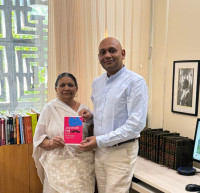
English translation of Abhay K’s ‘Fool Bahadur’ out
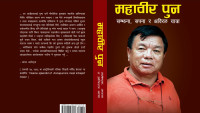
A trailblazer’s tale of service and progress
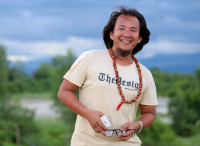
Books will remain integral to human existence
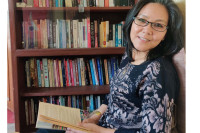
Female writers need more support
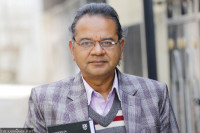
Learning should reflect on behaviour
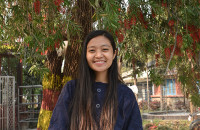
Books make me feel less lonely
Most read from books.
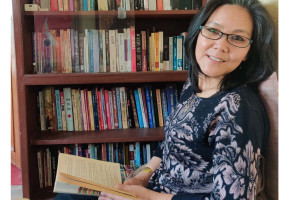
Editor's Picks
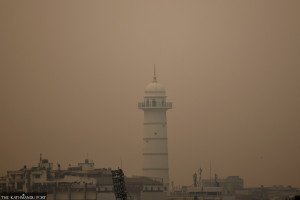
Kathmandu Valley’s toxic air exacerbates respiratory illness
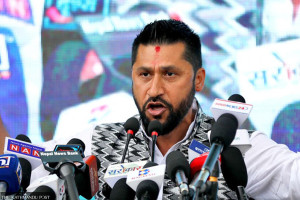
Rabi’s Freudian slip

Nepal’s first ‘post-pandemic Covid wave’

Jobs being created in Nepal lack quality: Experts

Kathmandu’s public transport remains an ordeal for many
E-paper | april 10, 2024.
- Read ePaper Online
- Share full article
Advertisement
Supported by
Guest Essay
José Andrés: Let People Eat

By José Andrés
Mr. Andrés is the founder of World Central Kitchen.
In the worst conditions you can imagine — after hurricanes, earthquakes, bombs and gunfire — the best of humanity shows up. Not once or twice but always.
The seven people killed on a World Central Kitchen mission in Gaza on Monday were the best of humanity. They are not faceless or nameless. They are not generic aid workers or collateral damage in war.
Saifeddin Issam Ayad Abutaha, John Chapman, Jacob Flickinger, Zomi Frankcom, James Henderson, James Kirby and Damian Sobol risked everything for the most fundamentally human activity: to share our food with others.
These are people I served alongside in Ukraine, Turkey, Morocco, the Bahamas, Indonesia, Mexico, Gaza and Israel. They were far more than heroes.
Their work was based on the simple belief that food is a universal human right. It is not conditional on being good or bad, rich or poor, left or right. We do not ask what religion you belong to. We just ask how many meals you need.
From Day 1, we have fed Israelis as well as Palestinians. Across Israel, we have served more than 1.75 million hot meals. We have fed families displaced by Hezbollah rockets in the north. We have fed grieving families from the south. We delivered meals to the hospitals where hostages were reunited with their families. We have called consistently, repeatedly and passionately for the release of all the hostages.
All the while, we have communicated extensively with Israeli military and civilian officials. At the same time, we have worked closely with community leaders in Gaza, as well as Arab nations in the region. There is no way to bring a ship full of food to Gaza without doing so.
That’s how we served more than 43 million meals in Gaza, preparing hot food in 68 community kitchens where Palestinians are feeding Palestinians.
We know Israelis. Israelis, in their heart of hearts, know that food is not a weapon of war.
Israel is better than the way this war is being waged. It is better than blocking food and medicine to civilians. It is better than killing aid workers who had coordinated their movements with the Israel Defense Forces.
The Israeli government needs to open more land routes for food and medicine today. It needs to stop killing civilians and aid workers today. It needs to start the long journey to peace today.
In the worst conditions, after the worst terrorist attack in its history, it’s time for the best of Israel to show up. You cannot save the hostages by bombing every building in Gaza. You cannot win this war by starving an entire population.
We welcome the government’s promise of an investigation into how and why members of our World Central Kitchen family were killed. That investigation needs to start at the top, not just the bottom.
Prime Minister Benjamin Netanyahu has said of the Israeli killings of our team, “It happens in war.” It was a direct attack on clearly marked vehicles whose movements were known by the Israel Defense Forces.
It was also the direct result of a policy that squeezed humanitarian aid to desperate levels. Our team was en route from a delivery of almost 400 tons of aid by sea — our second shipment, funded by the United Arab Emirates, supported by Cyprus and with clearance from the Israel Defense Forces.
The team members put their lives at risk precisely because this food aid is so rare and desperately needed. According to the Integrated Food Security Phase Classification global initiative, half the population of Gaza — 1.1. million people — faces the imminent risk of famine. The team would not have made the journey if there were enough food, traveling by truck across land, to feed the people of Gaza.
The peoples of the Mediterranean and Middle East, regardless of ethnicity and religion, share a culture that values food as a powerful statement of humanity and hospitality — of our shared hope for a better tomorrow.
There’s a reason, at this special time of year, Christians make Easter eggs, Muslims eat an egg at iftar dinners and an egg sits on the Seder plate. This symbol of life and hope reborn in spring extends across religions and cultures.
I have been a stranger at Seder dinners. I have heard the ancient Passover stories about being a stranger in the land of Egypt, the commandment to remember — with a feast before you — that the children of Israel were once slaves.
It is not a sign of weakness to feed strangers; it is a sign of strength. The people of Israel need to remember, at this darkest hour, what strength truly looks like.
José Andrés is a chef and the founder of World Central Kitchen.
The Times is committed to publishing a diversity of letters to the editor. We’d like to hear what you think about this or any of our articles. Here are some tips . And here’s our email: [email protected] .
Follow the New York Times Opinion section on Facebook , Instagram , TikTok , WhatsApp , X and Threads .
My experience here started with an essay on English lit. As of today, it is quite difficult for me to imagine my life without these awesome writers. Thanks. Always.
What is a good essay writing service?
Oddly enough, but many people still have not come across a quality service. A large number of users fall for deceivers who take their money without doing their job. And some still fulfill the agreements, but very badly.
A good essay writing service should first of all provide guarantees:
- confidentiality of personal information;
- for the terms of work;
- for the timely transfer of the text to the customer;
- for the previously agreed amount of money.
The company must have a polite support service that will competently advise the client, answer all questions and support until the end of the cooperation. Also, the team must get out of conflict situations correctly.
It is necessary to have several payment methods on the site to make it easier for the client to transfer money.
And of course, only highly qualified writers with a philological education should be present in the team, who will not make spelling and punctuation errors in the text, checking all the information and not stealing it from extraneous sites.
Customer Reviews
- Article Sample
- Terms & Conditions
- Privacy Policy
Diane M. Omalley
Is buying essays online safe?
Shopping through online platforms is a highly controversial issue. Naturally, you cannot be completely sure when placing an order through an unfamiliar site, with which you have never cooperated. That is why we recommend that people contact trusted companies that have hundreds of positive reviews.
As for buying essays through sites, then you need to be as careful as possible and carefully check every detail. Read company reviews on third-party sources or ask a question on the forum. Check out the guarantees given by the specialists and discuss cooperation with the company manager. Do not transfer money to someone else's account until they send you a document with an essay for review.
Good online platforms provide certificates and some personal data so that the client can have the necessary information about the service manual. Service employees should immediately calculate the cost of the order for you and in the process of work are not entitled to add a percentage to this amount, if you do not make additional edits and preferences.
Our Team of Professional Essay Writers
As we are an honest and well-paying essay writer service, writers come flying our way. Nonetheless, in the writers' community, we are known for our strict selection process. You as a client can be sure that you will be working with the best paper writer in the game no matter your subject or the difficulty of the task as all our writers go through testing and have their degrees checked. Only 3% of all applicants are accepted to work with us and even these 3% have a training program and a two-month trial period ahead. We value our reputation and only hire true experts with years of experience in academic writing behind their backs. Nonetheless, being a professional writers service has its challenges. For example, as our employer expectations are high, not all writers can handle the challenge of creating zero-plagiarism essay writing content in a short time frame, so as leading writing services we must keep everything in control.
receive 15% off

IMAGES
VIDEO
COMMENTS
Nepal, long under the rule of hereditary prime ministers favouring a policy of isolation, remained closed to the outside world until a palace revolt in 1950 restored the crown's authority in 1951; the country gained admission to the United Nations in 1955. In 1991 the kingdom established a multiparty parliamentary system.In 2008, however, after a decadelong period of violence and turbulent ...
History of Nepal. A map of Greater Nepal with the book published in 1819 by Francis Hamilton M. D. named "An Account of the Kingdom of Nepal and the Territories annexed to this Dominion by the House of Gorkha". Nepal is a multi-ethnic, multiracial, multicultural, multi-religious, and multilingual country.
250 Words Essay on History Of Nepal Early Beginnings. Nepal's history is very old and rich. Long ago, small kingdoms were all over the land. In the 4th to 6th centuries, the Licchavi dynasty ruled, and we can still see their art in Nepal. They made beautiful statues and buildings. After them, the Malla dynasty came to power in the 12th century.
Itihasaa is a Non-Profit and Free Educational Resource with the mission of sharing Nepal's Invaluable Heritage with the World. Selfless Commitment to History of Nepal Itihasaa is a nationalist and patriotic movement aimed at fostering an intellectual culture among the people of Nepal.
A HISTORY OF NEPAL Nepal emerged as a unified state over 200 years ago, centred on the Kathmandu Valley with its 2000 years of urban civilisation. While John Whelpton's history focuses on the period since the overthrow of the Rana family autocracy in 1950-1, the early chapters are devoted to
Nepal, officially the Federal Democratic Republic of Nepal, is a landlocked country in South Asia.It is mainly situated in the Himalayas, but also includes parts of the Indo-Gangetic Plain.It borders the Tibet Autonomous Region of China to the north, and India to the south, east, and west, while it is narrowly separated from Bangladesh by the Siliguri Corridor, and from Bhutan by the Indian ...
Ancient history of Nepal. Unification of Nepal. Kingdom of Nepal. Nepalese democracy movement. 1960 Nepal coup d'état. Nepalese Civil War. History of Asia. King of Nepal. Politics of Nepal.
He started a hereditary reign of the Rana Prime Ministers that lasted for 104 years. The Ranas were overthrown in a democracy movement of the early 1950s with support from the-then monarch of Nepal, King Tribhuvan. Soon after the overthrow of the Ranas, King Tribhuvan was reinstated as the Head of the State. In early 1959, Tribhuvan's son ...
This article explores the foundations of Nepali nationalism and its articulation in contemporary Nepal. It makes informed readings of the historical antecedents of Nepali national identity and argues that Nepali national identity was forged in an attempt to create and maintain a boundary with 'outsiders' - mainly India and China.
1872 Words8 Pages. History of Nepal. History of Nepal is interesting with an event of past. The holy book, Puran, and chronicle mention an origin of the Himalaya and Valley. An old tooth of the Ramapithecus was discovered in 1932 by G. Edward Lewis. The discovery tooth of Ramapithecus was in Shivalik hills near the Lumbini (bank of Tinau River ...
Remembering and Remaking Nepal's Founder: A Visual History of Prithvinarayan Shah Dannah Dennis and Avash Bhandari South Asia has many traditions of nationalist iconography of divine mother gures.1 In this essay, however, we will focus on the history of visual representation of Nepal's national founding father, Prithvinarayan Shah (r. 1742 ...
The Kathmandu Valley, which was already called "Nepal" centuries before the emergence of the modern nation-state of that name, is a 220 square mile bowl, 4,000 feet up in the lap of the ...
In an illustrious academic career spanning decades, several generations of Nepal-focused scholars were privileged to be trained by him. He maintains close ties with academic institutions in Nepal, the most significant being the Cornell Nepal Study Program (CNSP) in collaboration with Tribhuvan University, Nepal, initiated in 1993.
Nepal is a country with a rich cultural heritage, blending Hindu and Buddhist influences and reflecting the presence of various ethnic groups. The country has a long history, with cultural influences from Hinduism and Buddhism and ruled by different dynasties and kingdoms. The majority of Nepalese people practice Hinduism, with Buddhism being ...
The culture of Nepal encompasses the various cultures belonging to the 125 distinct ethnic groups present in Nepal. [1] The culture of Nepal is expressed through music and dance; art and craft; folklore; languages and literature; philosophy and religion; festivals and celebration; foods and drinks .
Essay on My Country Nepal For Students. If there is a country's flag that stands out among all other countries it is the flag of Nepal. Our flag is very unique and cannot be compared to other countries' flags due to its shape. It also has a hidden meaning behind it which represents the country's peace-loving and friendly nature, bravery ...
School education evolved with political and social change in and beyond Nepal. There are regional, national and international political context that has shaped the growth of schools. Through formal schooling, the state began to socialise children and aimed to create a common 'Nepali' identity. This was done through the standardisation of ...
571 Words2 Pages. Customs and traditions differ from one part of Nepal to another. A conglomeration lies in capital city Kathmandu where cultures are blending to form a national identity. Kathmandu Valley has served as the country's cultural metropolis since the unification of Nepal in the 18th Century.A prominent factor in a Nepali's ...
Guest Essay. José Andrés: Let People Eat. April 3, 2024. ... In the worst conditions, after the worst terrorist attack in its history, it's time for the best of Israel to show up. You cannot ...
The politics of Nepal functions within the framework of a parliamentary republic with a multi-party system. Executive power is exercised by the Prime Minister and their cabinet, while legislative power is vested in the Parliament.. The Governing Nepali Congress and Communist Party of Nepal (UML) have been the main rivals of each other since the early 1990s, with each party defeating the other ...
Essay On Major Events In History Of Nepal. EssayService strives to deliver high-quality work that satisfies each and every customer, yet at times miscommunications happen and the work needs revisions. Therefore to assure full customer satisfaction we have a 30-day free revisions policy. User ID: 102891.